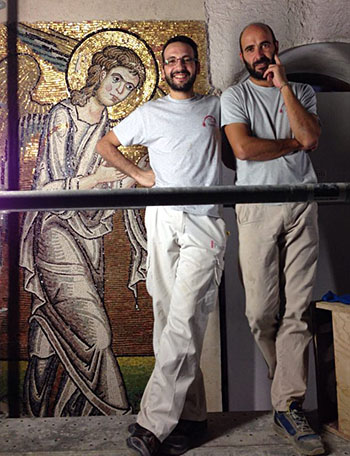
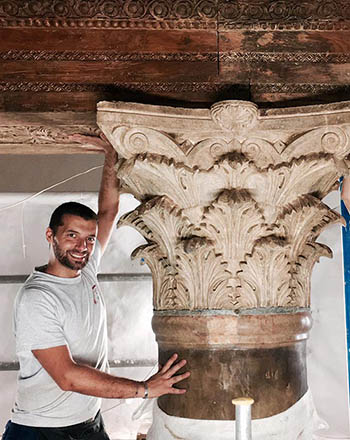
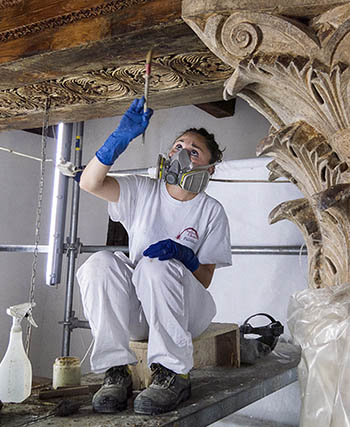
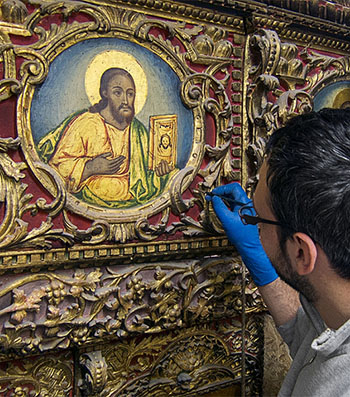
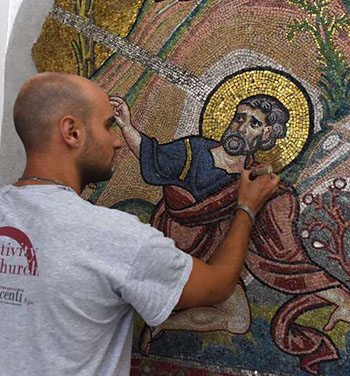
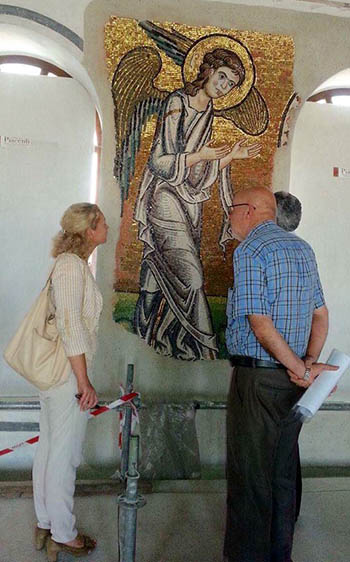
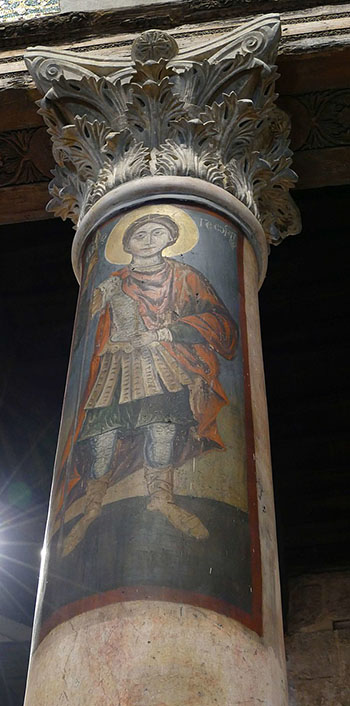
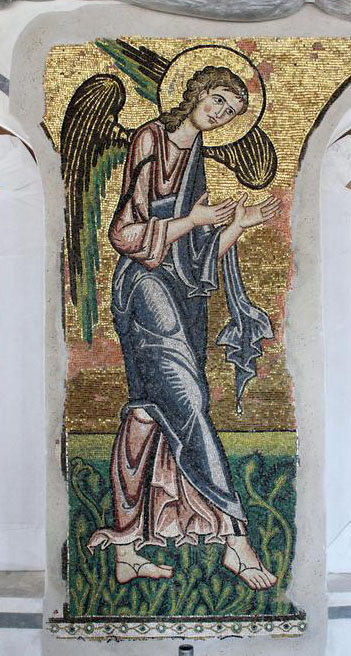
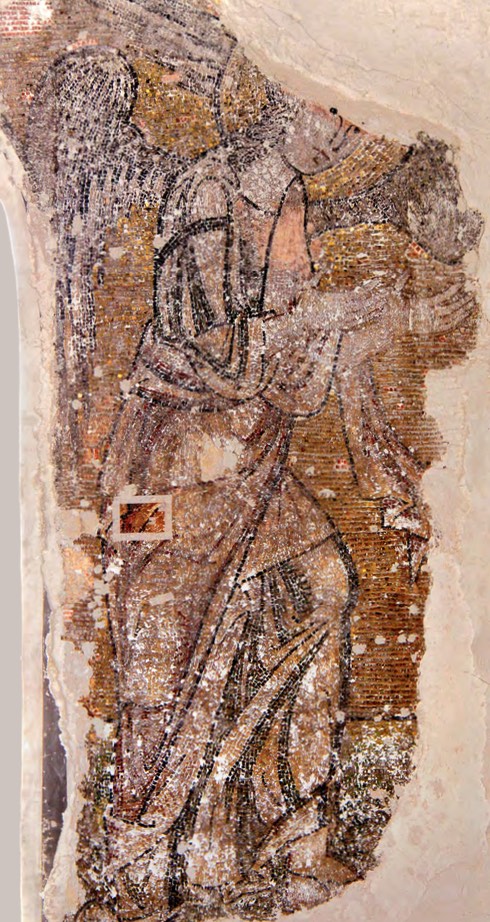
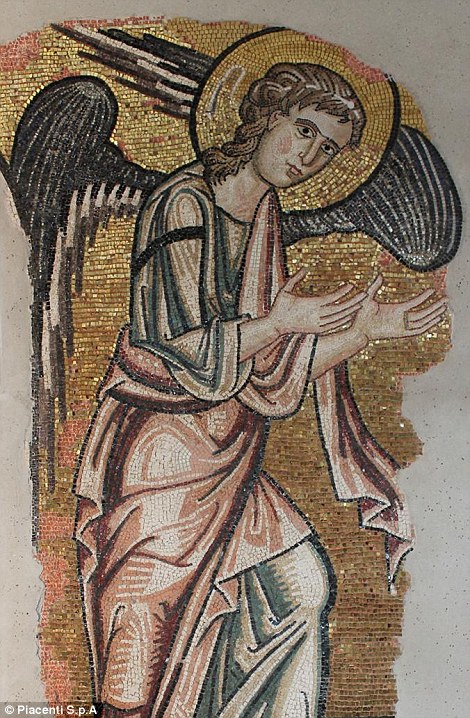

Mosaics in the Church of the Nativity in Bethlehem
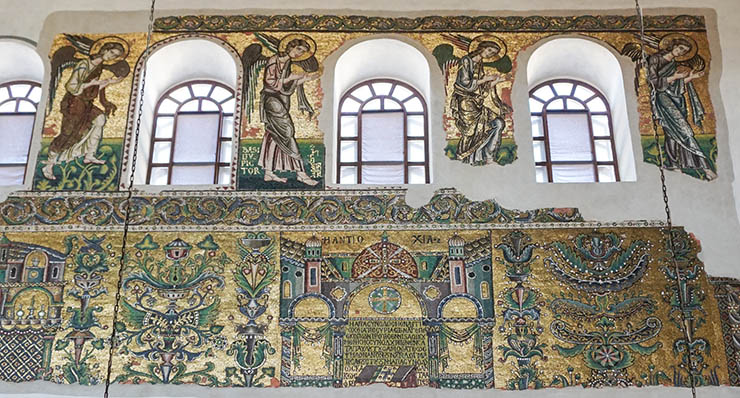 The mosaics were completed in 1169 and were restored from March 2015 until June 2016 by the Italian firm, Piacenti, SpA. They began on the repair of the roof, then the cleaning of the stonework and finally the restoration of the mosaics. It's interesting that the architrave of the nave was made of 6th century wood, which was discovered to have decorative inlays. There are 50 red crystalline limestone columns - bases, shafts and capitals - in the church, 32 of them had encaustic wax paintings on them. In addition there are ten capitals without columns or bases. The columns came from a local quarry. Red Jerusalem limestone is easy to work and hardens after being cut. There was no need to import white Proconnesian or other colored marbles to the Holy Land since Jerusalem limestone came in so many colors and was produced in Imperial, state-owned quarries.
The mosaics were completed in 1169 and were restored from March 2015 until June 2016 by the Italian firm, Piacenti, SpA. They began on the repair of the roof, then the cleaning of the stonework and finally the restoration of the mosaics. It's interesting that the architrave of the nave was made of 6th century wood, which was discovered to have decorative inlays. There are 50 red crystalline limestone columns - bases, shafts and capitals - in the church, 32 of them had encaustic wax paintings on them. In addition there are ten capitals without columns or bases. The columns came from a local quarry. Red Jerusalem limestone is easy to work and hardens after being cut. There was no need to import white Proconnesian or other colored marbles to the Holy Land since Jerusalem limestone came in so many colors and was produced in Imperial, state-owned quarries.
The original church was built by Helena, mother of Constantine the Great, in 339AD and expanded by Justinian I in the 6th century who added the trefoil to the apse. The 4th century church was built over the traditional location of the birth of Christ since at least the 2nd century. It is the oldest Christian church in continuous daily use.
The first church of Constantine and Helena was probably destroyed in the Samaritan revolt of 529 during the reign of Justinian, who rebuilt it. During excavations a layer of ash and burnt wood was found on top of the Constantinian mosaic floor That was evidence of the destruction. Prokopios of Caesarea does not mention the Church of the Nativity in De Aedificiis but merely refers to the rebuilding of the walls at Bethlehem by Justinian. In view of the church’s obvious significance, it seems probable that the Justinianic edifice was constructed after the completion of Prokopios’ work, rather than simply an accidental omission. I haven't found anything that clarifies the origin of the columns and capitals, whether they are from the era of Constantine or Justinian. If the church was burned then the capitals would show damage - but they look perfect - so they must be newly made in Justinian's time.
It was during the Samaritan revolt that Justinian brought the Holy Well to Hagia Sophia.
At the time the mosaics were put up in the the Greek-speaking families of the Crusader Kingdom of Jerusalem celebrated the liturgy in Greek, yet the bulk of the Orthodox population, peasants and urban dwellers, spoke Arabic and used Syriac in their liturgy. When the crusaders conquered Jerusalem they expelled the orthodox bishops clergy from the cathedrals and left the village churches and monasteries in the hands of the native clergy, which they were not in a position to support.
The roof was made of cedar, oak, cypress, pine and larch. The pine and larch came from the Italian alps and were harvested, milled and transported in the 15th century by the Venetians to Bethlehem. The Byzantines used pine in the construction of roofs in Constantinople. It came in very long straight logs - up to 100 ft - which were light and durable from local forests. Pine needs to have all of its sap removed during milling. Inscriptions were found on the wood beams. One of them appears to be music notes in the form of peacock feathers.
There had a been or program of restoration and redecoration of the church since 1130 when the paintings of saints were added to the nave columns. There were formerly two dedication inscriptions, one in Latin and the other in Greek. They tell us the work was completed by Ephraim, "the monk, artist and mosaicist". Manuel I Komnenos, the Byzantine Emperor commissioned the work and paid for it. The full inscription reads:
"The present work was finished by the hand of Ephraim the monk, painter and mosaicist, in the reign of the great emperor, Manuel Porphyogennetos Komnenos and in the time of the great king of Jerusalem, Lord Ammori. and of the most holy bishop of holy Bethlehem, the Lord Raoul (Ralph), in the year 6677, second indiction"
A second artist is mentioned, Basil the Deacon, whose name is listed in Syriac (a liturgical language that was not spoken in everyday life) to the left of one of the angels "Basil the deacon depicted this". There was also a third artist whose name is only partially preserved in Greek, "remember, Lord, your servant Zan..."
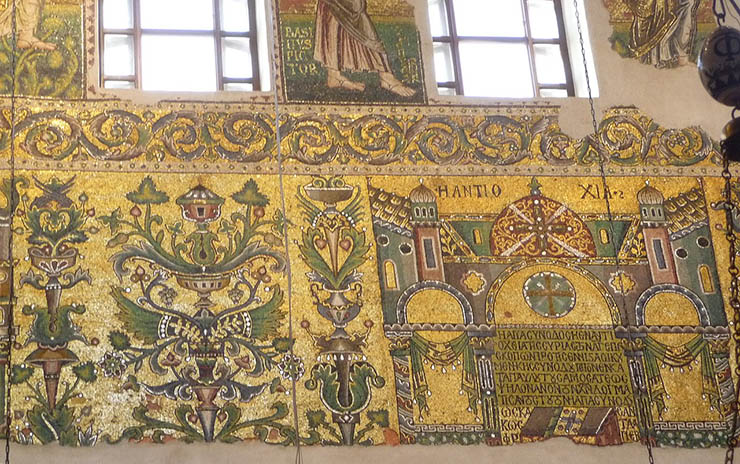
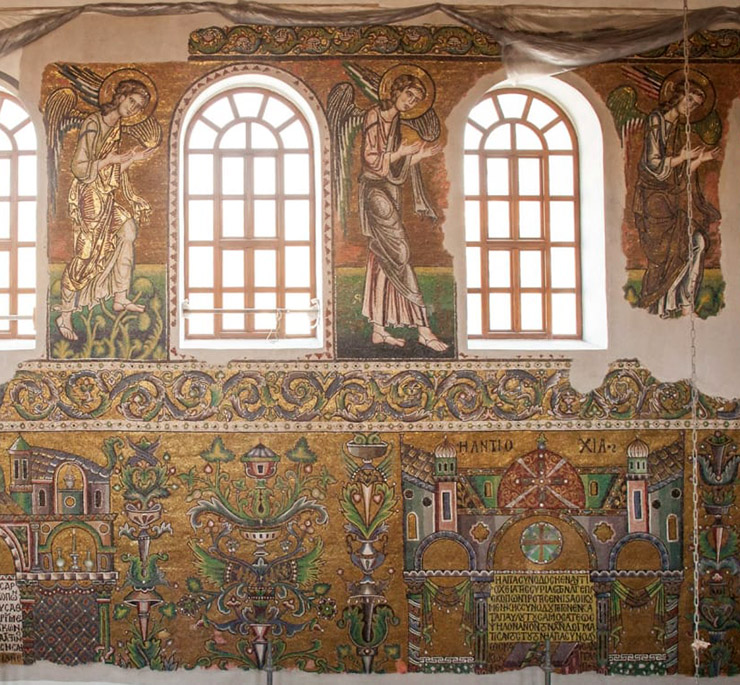
The procession of angels might duplicate angels in the enamels of the Pala d'Oro in Saint Marks in Venice, seen below. These were said to have originated in Komnenian church of the Pantokrator in Constantinople. All of the figures and ornament can be seen in the artistic orbit of the so called Kokkinobaphos school. It is possible that the designs for the mosaics were done in a Kokkinobaphos workshop and sent along with a supervising artist, perhaps Ephraim himself. Duplicates of the motifs in the acanthus scrolls of flowers, birds and beasts can be seen in the Gospels of Theophanes and the Gospels of John II produced for the imperial family.
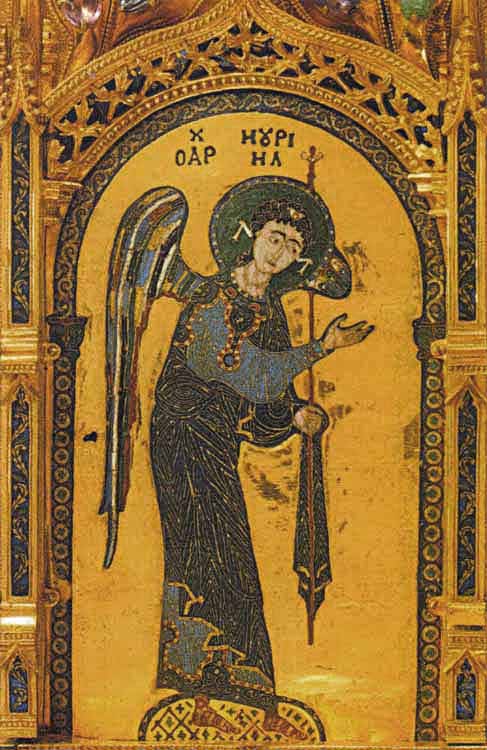 Originally the entire nave and apse were decorated. Fortunately drawings were made of the mosaics in 1693, which help us to understand the full plan. It is thought Ephraim did the mosaics in the choir, Basil did the nave and the third artist did the transepts. Ephraim was a Byzantine artist who was sent from Constantinople by Manuel. His name is given prominence because it is seen in the apse. Basil was a Syrian Melkite and could have been already a resident of Bethlehem or Jerusalem. Many Syriac Christians came from the north and lived in these pilgrimage sites. Manuel's portrait was erected in several places in the decoration of the church including the sanctuary, the most important spot in the church after the cave of the nativity which was beneath the church. The date of the mosaics is just three years after Manuel hosted the opening session in the Triklinos of Manuel in the Great Palace of Constantinople which debated Christ's words "the Father is greater than I", John 14:28, and its theological meaning for orthodox Christians. Manuel I had the acts of the council carved on huge slabs of Proconnesian marble at set them on porphyry columns in the nave of Hagia Sophia. Somehow the mosaics of the Church of the Nativity fit in with Manuel's spiritual and political endeavors. The mosaics of the nave include images of church councils that were involved in defining the nature of Christ.
Originally the entire nave and apse were decorated. Fortunately drawings were made of the mosaics in 1693, which help us to understand the full plan. It is thought Ephraim did the mosaics in the choir, Basil did the nave and the third artist did the transepts. Ephraim was a Byzantine artist who was sent from Constantinople by Manuel. His name is given prominence because it is seen in the apse. Basil was a Syrian Melkite and could have been already a resident of Bethlehem or Jerusalem. Many Syriac Christians came from the north and lived in these pilgrimage sites. Manuel's portrait was erected in several places in the decoration of the church including the sanctuary, the most important spot in the church after the cave of the nativity which was beneath the church. The date of the mosaics is just three years after Manuel hosted the opening session in the Triklinos of Manuel in the Great Palace of Constantinople which debated Christ's words "the Father is greater than I", John 14:28, and its theological meaning for orthodox Christians. Manuel I had the acts of the council carved on huge slabs of Proconnesian marble at set them on porphyry columns in the nave of Hagia Sophia. Somehow the mosaics of the Church of the Nativity fit in with Manuel's spiritual and political endeavors. The mosaics of the nave include images of church councils that were involved in defining the nature of Christ.
Manuel would have been involved in every detail of the choice of subject matter, the layout and style of the mosaics. He hoped to travel to Bethlehem and Jerusalem as a pilgrim, but the death of the king of Jerusalem, Almaric put an end to those plans.
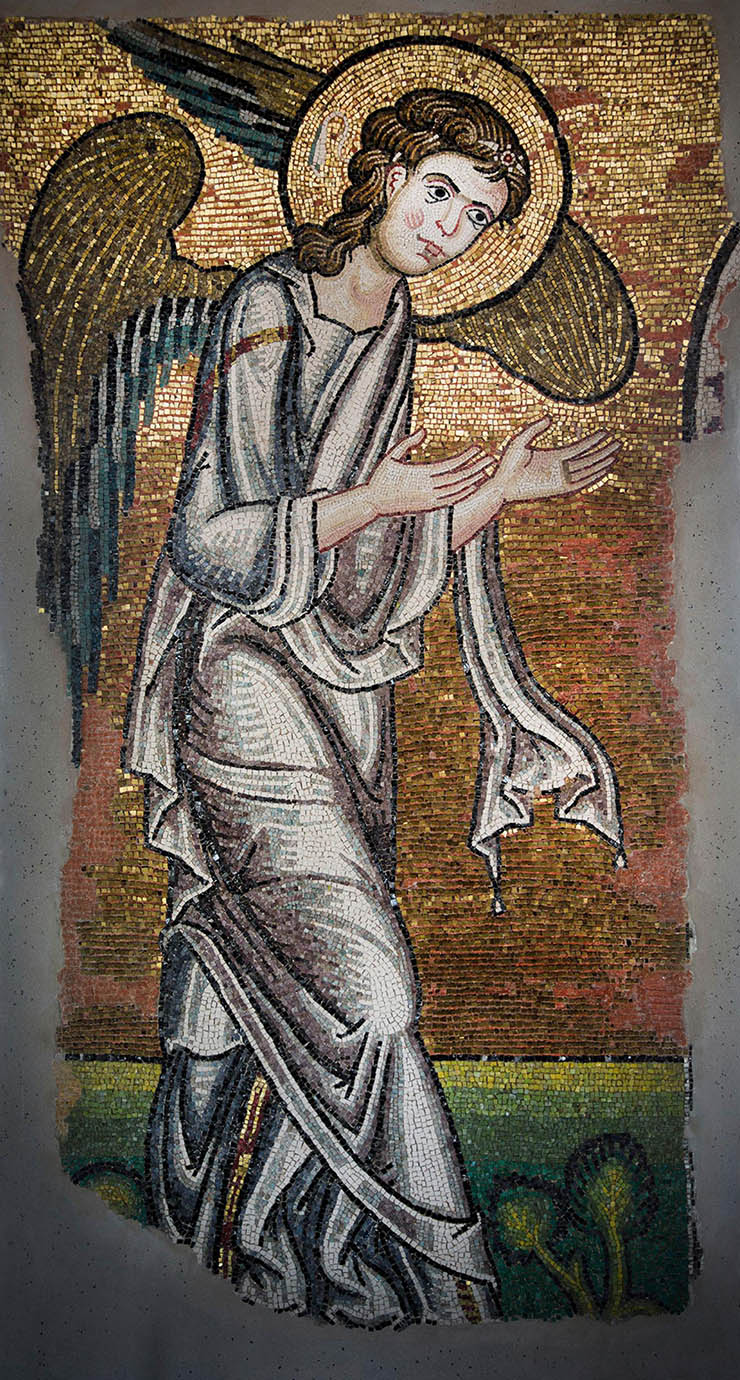
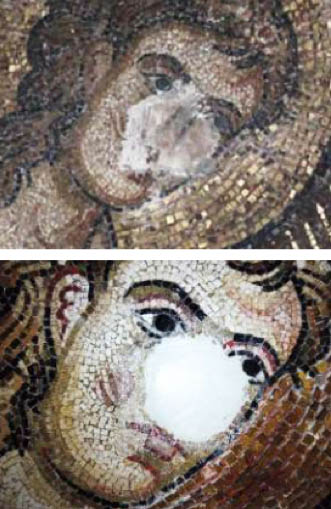 There were many lead balls embedded in the mosaics. The mosaics were intentionally damaged by Islamic zealots. The angel above was damaged, its face had been shot out by Turkish harquebus shots reported in the late sixteenth and seventeenth centuries. It was reported that only images of Mary were left undamaged, because of the respect Muslims had for her as the mother of Jesus, who they regard as a prophet.
There were many lead balls embedded in the mosaics. The mosaics were intentionally damaged by Islamic zealots. The angel above was damaged, its face had been shot out by Turkish harquebus shots reported in the late sixteenth and seventeenth centuries. It was reported that only images of Mary were left undamaged, because of the respect Muslims had for her as the mother of Jesus, who they regard as a prophet.
On the left you can see the condition of the face before cleaning and restoration midway in its completion. It was decided to fully restore the face of the angel, a wise decision. There is one small error, the line beneath the right eye runs in the wrong direction.
Above you can see a strong black line separating the green grass from the gold background. Artist's manuals advise against setting green and gold mosaic right next to each other. They say it makes the gold look cheap. The grass is set with thick, unusual plants and flowers that are different on every angel.
During the initial survey of the mosaics an angel was discovered between the 4th and 5th windows on the north side concealed beneath plaster that was smeared over it in 1842. As you can see it was heavily damaged. In the right column there is an image showing the condition of the mosaics as it was discovered. Even in this condition one can see the elegant proportions and classical influences in Komnenian art. It can be compared with mosaic work at Daphni outside Athens which was created 30-40 years prior. The restoration can be seen below it - what an amazing transformation. It was a brave decision to restore the top of the head, clothes and background.
Above the frieze of angels there is another acanthus-like border. This one has mushrooms which you can see below.
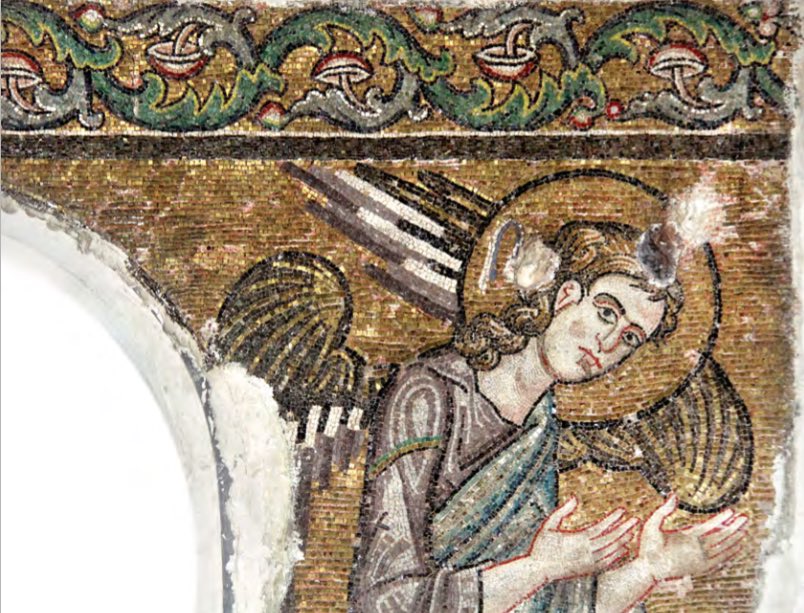
Above you can see the marks around the face of the angel where Ottoman troops fired lead shot into the mosaics.
There is a great deal of architectural and arabesque ornament in the mosaics and there are several altars depicted. It is possible this ornament was influenced by the mosaics put up in the Dome of the Rome in 691 and mosaics on the facades of the Great Mosque in Damascus in 706. Perhaps they are free copies of mosaics Manuel put up in Constantinople. A Syrian artist named Thomas, "monk-painter of Damascus", is recorded to have set mosaics in the Church of the Holy Sepulcher which were completed in 1149, 20 years before the mosaics in the Church in the Nativity.
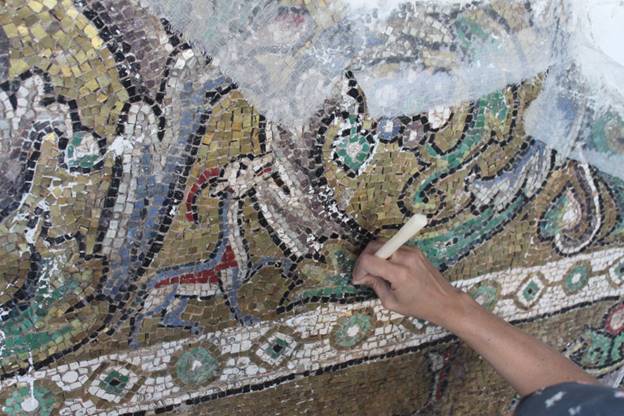 There is a big band of scrolled acanthus that wraps the nave. The acanthus has animals in it, which you can see on the left. At the top and bottom is a white band set with jewels. The acanthus is lively and shows great inventiveness in its patterns. This motif was very old in Manuel's time and we see it in places like the arches of the nave and secret rooms of Hagia Sophia, which were decorated in the 7th century, and the pavement of the Great Palace from the 6th century.
There is a big band of scrolled acanthus that wraps the nave. The acanthus has animals in it, which you can see on the left. At the top and bottom is a white band set with jewels. The acanthus is lively and shows great inventiveness in its patterns. This motif was very old in Manuel's time and we see it in places like the arches of the nave and secret rooms of Hagia Sophia, which were decorated in the 7th century, and the pavement of the Great Palace from the 6th century.
The Church of the Theotokos of the Blachernae was decorated like this.
Below is another detail showing a scroll ending in a wolf head and another surrounding a chalice. At the top is a rabbit.
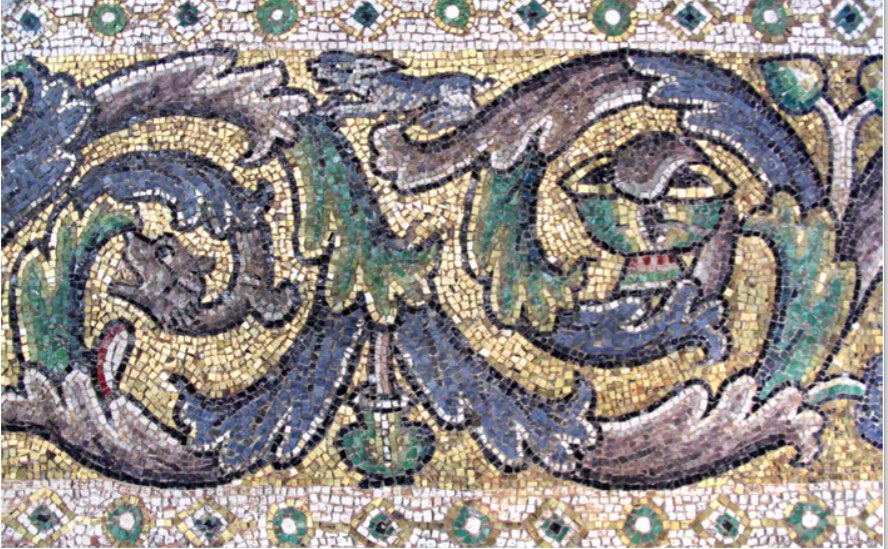
The 8 ft. tall angels are delightful and dance in procession toward the apse. There is a great variety in their poses, and their robes are sensitively modeled. Their figures are well-drawn with softly modeled, bright faces. The angels with open legs - left leg forward - are more attractive then those with closed legs. The angel above is an example of a closed leg angel. I think two artists did the angels alternating one after another. Probably one artist did the open leg angels and the other the closed ones. You can see a difference in the drawing of the hair, the modeling of the faces and in the light feathers of the wings. Some of the angels look at you others do not. The work would have started at the top with the mushroom frieze and the angels and moved down as the scaffolding was moved. It's possible each angel took two days to put up. The work could move very fast. The primary artists had assistance. Some of the work - like the complex borders - must have been very tedious. The gold tesserae are laid at an angle so they reflect the light down to people in the nave. These mosaics sparkle.
Most of the glass tesserae were made new for the project, but there was a mixture of reused cubes.
Pilgrims to the church reported Muslim guides scraped gold mosaic off the walls and gave it to them as souvenirs. Vandals also took gold mosaic thinking they could extract the gold. This also happened at Hagia Sophia in Istanbul during Turkish times.
Originally there was a mosaic of the Virgin and Child in the apse that was seen to be detaching from the wall in 1490. It had probably been damaged in a severe earthquake that hit Bethlehem around 40 years before. On either side of the Virgin were figures of David and Abraham. There was an annunciation in the arch of the apse that is also now lost.
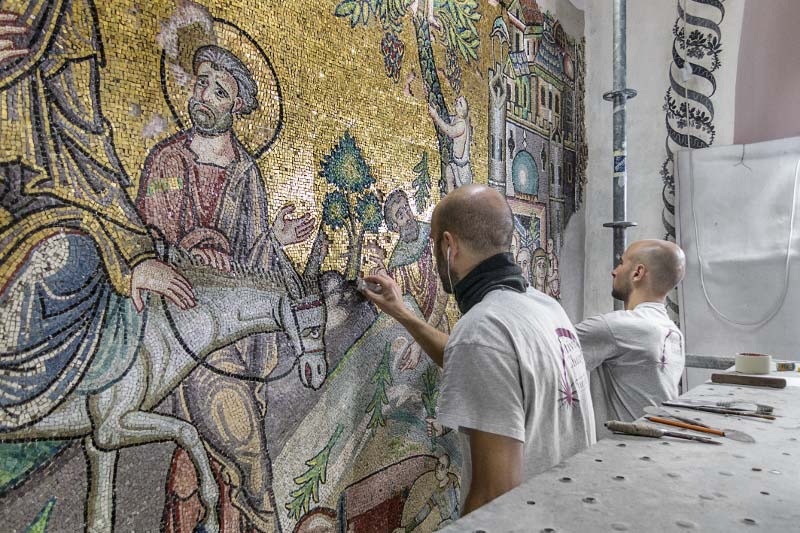 One can see how all of the main figures of the mosaics are life-sized, including the angels. As they worked the artists would have been able to judge the scale of the work against the size of their own bodies. It is thought artists used established measurements and circular compasses to plan the proportions of the figures.
One can see how all of the main figures of the mosaics are life-sized, including the angels. As they worked the artists would have been able to judge the scale of the work against the size of their own bodies. It is thought artists used established measurements and circular compasses to plan the proportions of the figures.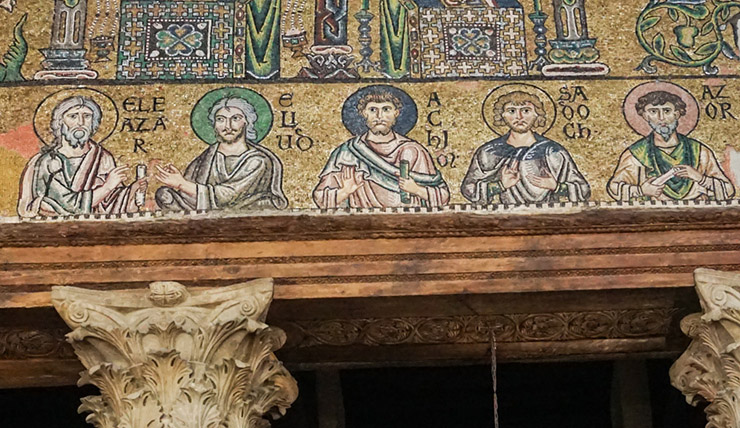 There was a band of images of saints - the ancestors of Christ - that ran on both sides of the nave. Notice how there are four different colors of halos, gold, red, blue and green. Their inscriptions here are in Latin and there were originally 42 on each side. The variety in the images is amazing there is not evidence of repetition like you see in the figures of the male and female martyrs on either side of Sant'Apollinare Nuovo in Ravenna.
There was a band of images of saints - the ancestors of Christ - that ran on both sides of the nave. Notice how there are four different colors of halos, gold, red, blue and green. Their inscriptions here are in Latin and there were originally 42 on each side. The variety in the images is amazing there is not evidence of repetition like you see in the figures of the male and female martyrs on either side of Sant'Apollinare Nuovo in Ravenna.
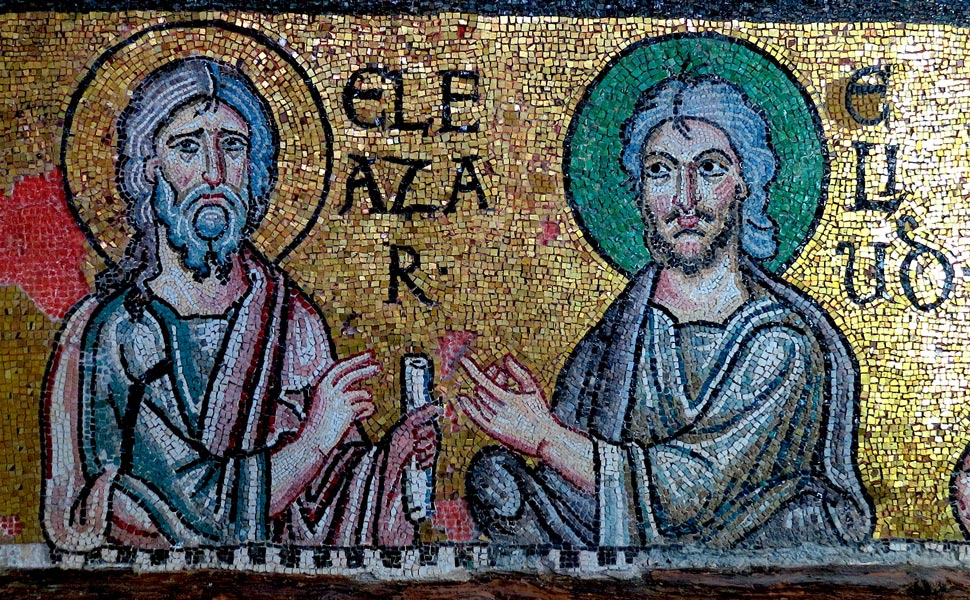
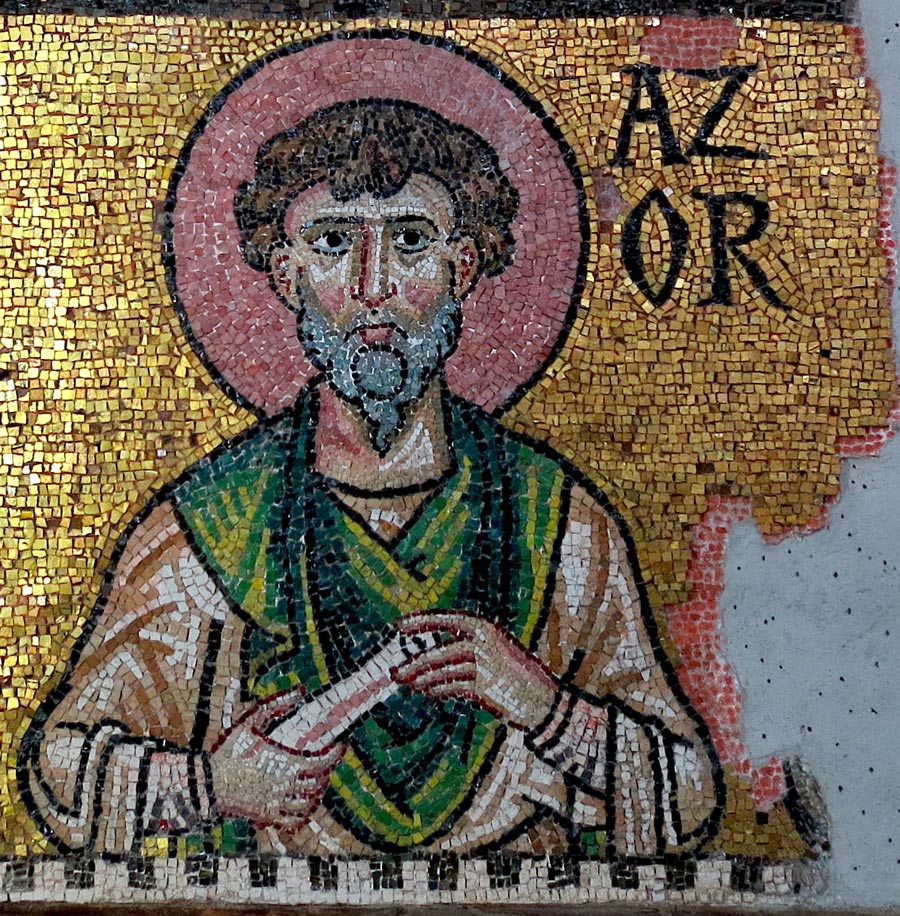
The church was run by a Latin Clergy who would have been involved in auditing the messages, themes and inscriptions to make sure they did not conflict with Catholic ideology. The recent readmission of Greek canons to the Church of the Holy Sepulchre in 1166 was a sign of improved relations between Greek and Latin clergy in the shrines of the Holy Land.
Manuel began his reign by fulfilling the pledge of his father, John II, to present the shrine over the tomb of Christ with a golden lamp weighing 20 pounds. Over several decades Manuel made many donations of icons, liturgical vessels, fabrics and manuscripts to monasteries and churches throughout the Crusader Kingdom. He also financed the restoration of at least one monastery ceded by the Hospitallers to the Orthodox archbishop of Gaza. He had activity promoted the reunion of the Armenian and Syriac churches with Constantinople and spent a great deal of time and money in the Crusader Kingdom expanding his influence.
During the period between 1158 and 1171, Manuel attempted to impose his authority over the King of Jerusalem partly with the help of his marital policy. In 1167 King Amalric wedded Maria Komnene, a great-niece of Emperor Manuel I, whose presence at the royal court of Jerusalem until 1174 must have furthered Orthodox causes. Two years after the completion of the mosaics in 1171 Manuel hosted Almaric, the Frankish King of Jerusalem, in Constantinople. During his visit he was shown all of the wonders and treasures within and outside of the walls of the city.
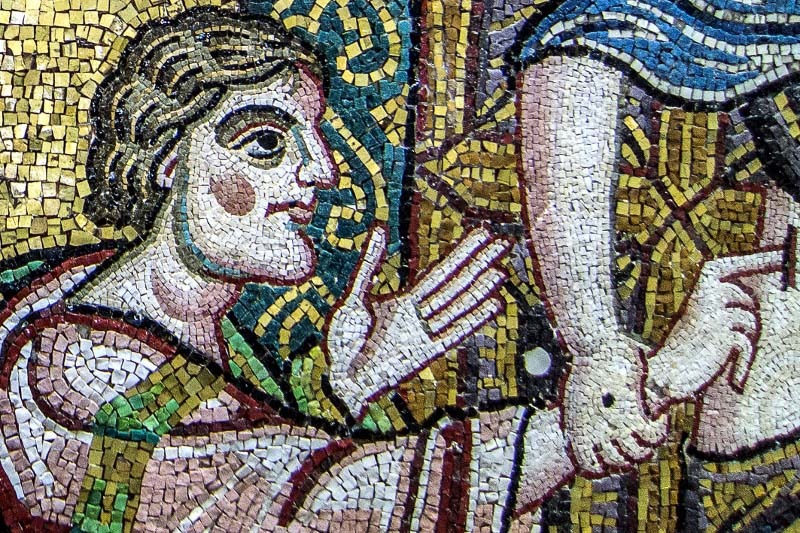 This is close-up of a scene of the doubting Thomas with Christ. a figure like this in profile - and lacking a halo - is unusual in Byzantine art, however Manuel's artists would have done many secular mosaics for him in his palaces. Most of his secular mosaics from his reign depicted historical events - like battles. Look at the wonderful variety of colors in the glass mosaic. The glass cubes could have been made locally in Palestine or imported from Constantinople. The production of glass requires huge amounts of wood for the furnaces. Constantinople had no shortage of wood, while I don't know how much wood was readily available around Bethlehem. Wood could have been imported.
This is close-up of a scene of the doubting Thomas with Christ. a figure like this in profile - and lacking a halo - is unusual in Byzantine art, however Manuel's artists would have done many secular mosaics for him in his palaces. Most of his secular mosaics from his reign depicted historical events - like battles. Look at the wonderful variety of colors in the glass mosaic. The glass cubes could have been made locally in Palestine or imported from Constantinople. The production of glass requires huge amounts of wood for the furnaces. Constantinople had no shortage of wood, while I don't know how much wood was readily available around Bethlehem. Wood could have been imported.
Glass was blown into big flat disks in the colors required for the project. It was cut into cubes onsite. Gold glass was made by inserting one or two layers of gold between two layers of glass.
The green in the leafy ornament has been laid in around 5 different tones of glass tesserae, which were also used in backgrounds and in figures like Thomas. In this picture we can see how the green is very harmonious with the pink shades of the human figures. As you can see below none of the apostles have halos - most unusual.
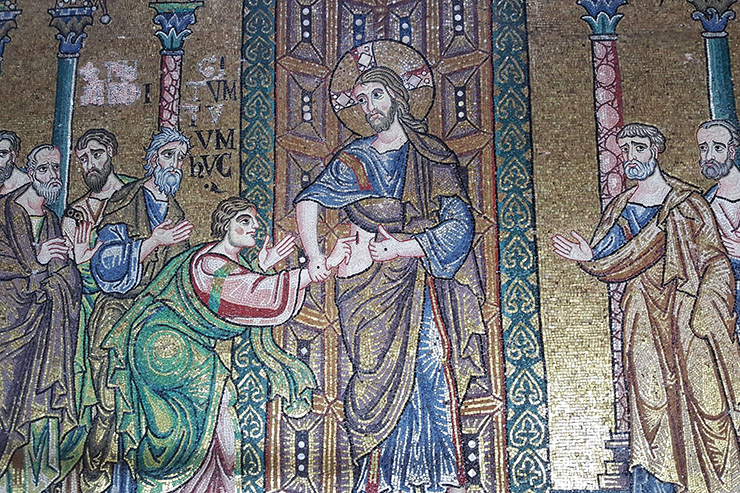
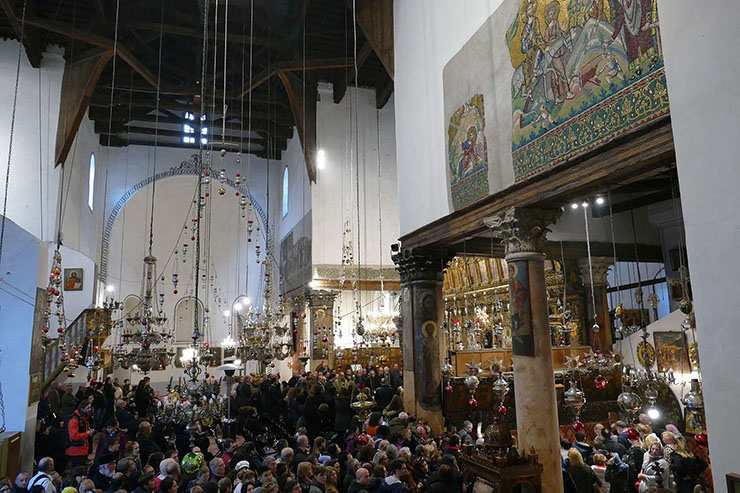
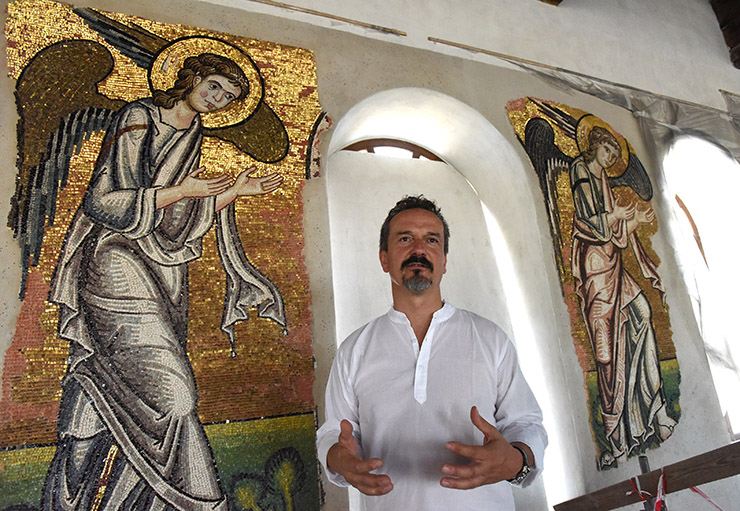

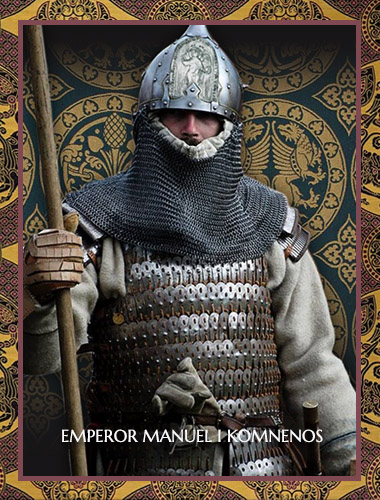


 click here for icons of christ
click here for icons of christ click here for icons of the theotokos
click here for icons of the theotokos click here for icons of angels
click here for icons of angels click here for icons of saints
click here for icons of saints








